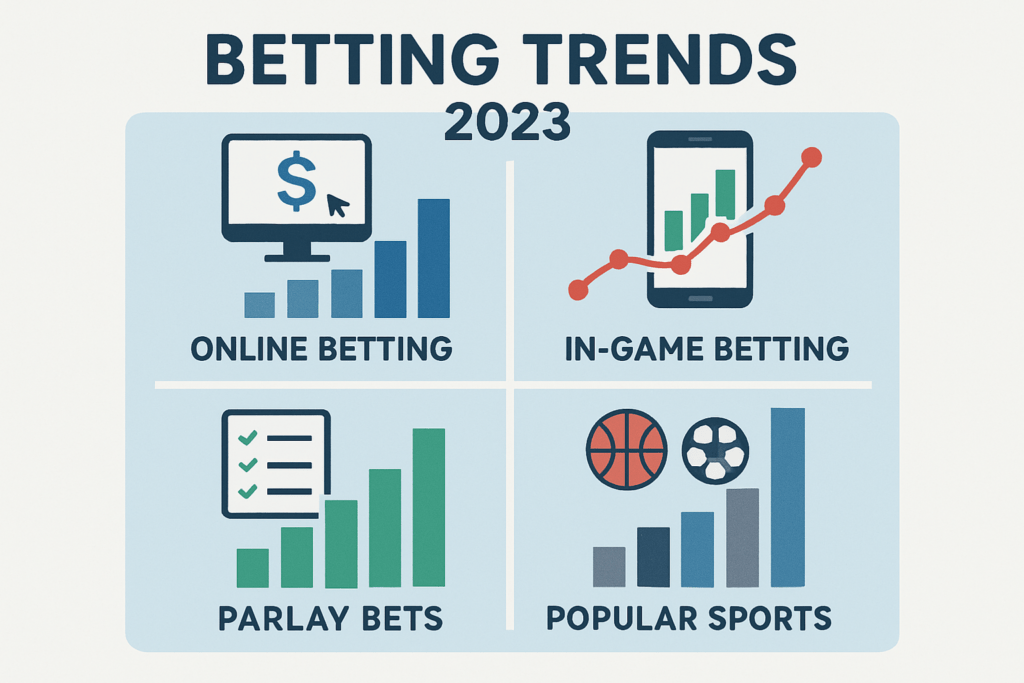Analyzing Betting Trends: Your Edge for Smarter Predictions
- Every sharp bettor knows: it’s not luck, it’s numbers that win long term.
- Understanding trends is the foundation of accurate, consistent predictions.
- Main keyword: analyzing betting trends.
Analyzing Betting Trends: Your Edge for Smarter Predictions
Here’s the blunt truth: betting without analyzing betting trends is just guesswork. The edge isn’t about hunches—it’s about spotting patterns before the market does. Sharp bettors grind through stats, historical data, and public behavior to gain that edge. By looking at how teams or players have performed in similar situations—home games after a loss, underdogs in divisional matchups, or even just their record against the spread—you’re hunting for repeatable edges.
Ignoring trends means ignoring what the numbers, and a mountain of previous bets, could already be telling you. Trends alone aren’t magic, but when you track them over time, they become reliable guideposts. That’s how you move from chasing luck to playing the percentages, and percentages—over the long haul—are what matter. The real secret? Consistently analyzing betting trends is what separates casual punters from those who actually beat the books.
Why Betting Trends Matter
At its core, betting is a battle between your insight and the odds. The house wants you to rely on gut instinct—don’t do it. Betting trends pull back the curtain on what’s really happening. When you study how teams perform in certain situations (like how NBA underdogs do on back-to-back nights) or how the public piles onto a favorite, you get a snapshot of repeatable patterns. These aren’t just stats for stat’s sake; these trends reveal where the market is slow to react, or where old biases linger.
Sharps—those pros who always seem a step ahead—aren’t psychic. They’re watching these patterns, testing them, and moving fast when something new emerges. The right trend, spotted early, can turn a so-so wager into pure value. But you need the right tools and methods to tell signal from noise. That’s where sharpened trend analysis methods and predictive betting analytics come in. Master those, and suddenly you’re not just another fan—you’re a smarter operator in a game that punishes wishful thinking.
Tools & Techniques: How to Analyze Trends Like a Pro
Analyzing betting trends isn’t rocket science, but it does take some structure and grit. First, everything starts with quality data. Before you even think about making a pick, dig up historical results, odds histories, and the ever-important injury reports. If you don’t have the raw facts, you’re just guessing.
Next, pay attention to who’s betting on what. Tracking public money versus sharp money lets you see which side is getting the action, and sometimes, that’s more telling than any stat sheet. Public bettors follow hype; sharp money usually knows something.
Now you’re ready for the fun part: trend analysis methods. Don’t just eyeball the numbers—smooth things out with moving averages and strip out random noise. Correlation analysis is straight-up essential; figure out which stats actually move the needle for outcomes instead of chasing flukes.
Then there’s pattern recognition. Certain matchups, time slots, or weather situations repeat themselves in sports like clockwork. Find those patterns, and you’ll find value others miss. It’s not just about collecting data, it’s about slicing it up and asking the right questions.
Want to dig even deeper? Don’t sleep on resources that break down betting behavior during major events. Real-time insights like these, especially during world cups or Super Bowls, can offer clues the numbers alone might miss. Bottom line—build your toolkit, keep it sharp, and treat every trend like it’s there to be broken. That’s how you stay ahead.
1. Start With the Raw Data
You can’t analyze trends without a foundation. That means data—real numbers, not gut feel. Start with historical results: who played, who won, who lost, by how much. Chart odds movement from opening to close to see where the smart money went and where public sentiment shifted. Don’t skip injury reports or lineup changes; the “questionable” tag is often a betting market trigger. Next, track where the money’s coming from. Sharp bettors and the public move lines in different ways, at different times. Services and forums often publish percentages of bets vs. money. Sharp cash is quieter, but it leaves footprints if you know where to look. The point: gather everything. The more quality data you have—raw and unfiltered—the clearer the patterns will become when you start slicing and dicing for real insights.
2. Apply Trend Analysis Methods
Once you’ve dug up the raw data, it’s time to start slicing it. Think of trend analysis like tuning out the chaos to hear the real story underneath. Moving averages? They’re your first filter. Instead of jerking around over every wild game or fluke injury, moving averages help you see the steady direction—the genuine performance curve.
Next up: correlation analysis. This is where you check if two things actually move together or if you’re just seeing faces in clouds. For example, does a dip in a team’s scoring average really correlate to their win rate, or is it a mirage? Calculating the correlation coefficient keeps you honest. Don’t just guess—let the numbers do the talking.
Then comes pattern recognition, the holy grail. Patterns repeat—not always, but often enough to spot value. This is gold in sports like football or basketball, where the same matchups and travel schedules repeat season after season. If you notice that underdogs cover the spread on Monday nights more than average, that’s a pattern worth testing. But beware: don’t trust everything you see. Always double-check that a “trend” isn’t just random noise.
Master these three methods, and you’ll have a sharper eye for value bets than 90% of the punters out there. Want to go even deeper? Check out the impact of major sports events on betting patterns.
Predictive Betting Analytics: Turning Data Into Action
You’ve got your data, and a handle on the trends. Now it’s time to actually use all that number-crunching to make better bets—this is where predictive betting analytics earns its keep. At the simple end, even basic regression analysis can show how different factors impact a point spread or over/under. Maybe it’s home field advantage, recent form, or even weather conditions; these things all move the needle, and regression helps you spot which ones actually matter, versus stats that just create noise.
Of course, predictive betting analytics gets a lot more complex if you want it to. If you’re ready to step up, machine learning models—things like decision trees or neural nets—can process thousands of variables and uncover hidden edges. But don’t get distracted: for most punters, grounding your picks in solid, testable trends will get you further than any AI buzzword. Use analytics to highlight actionable patterns, not just to dazzle yourself with charts.
Bottom line: blend stats, trends, and a dash of common sense. Predictive betting analytics is the toolkit for sharpening your edge, turning raw information into bets you’re actually proud to place—consistently, not just by luck.
Forecasting Techniques for Better Bets
Forecasting is where the numbers start pulling their weight. Strip it down: focus on what actually moves the needle. Recent form isn’t hype—it’s the most honest indicator you have. Look at how a team or athlete has been performing in their last five games, not just the big wins six months ago. Head-to-head records give you clues to psychological matchups and strategic edges. If one team always stumbles against a certain opponent, that’s not just coincidence—there’s something real there.
Injuries? Don’t just glance at the list; think about impact. Is the missing player a benchwarmer or the quarterback? Context changes everything.
Blending both soft and hard signals is key. Gut feelings are just noise unless you can back them up with data. Let the stats inform your instincts. If a trend lines up with a narrative—great. If not, trust the numbers.
One advanced technique is tracking closing line value (CLV). Think of CLV as a sort of “betting compass.” If you consistently get a better number than where the market closes, you’re probably on the right side of sharp action—even if variance bites you short-term.
These are your bread-and-butter forecasting techniques. Don’t overcomplicate it. Discipline and clear-eyed analysis will put you ahead of most in the long run.
Common Pitfalls in Trend Analysis
It’s easy to get carried away when analyzing betting trends, so let’s cut the fluff and talk about where most folks trip up. First: overfitting. This is when you see a “trend” that’s really just random noise—like thinking teams always win on Tuesdays because you saw it happen a few times. Just because something happened in the past doesn’t mean it repeats unless the logic underpins it.
Next up: ignoring new variables. Sports aren’t static. Weather changes, rules get tweaked, star players sit out. If you’re not updating your analysis with the latest info, your trends are already stale. A trend stops being useful the moment the underlying conditions change.
Finally, don’t marry your narrative. Your favorite theory about why a team wins can blind you. Always let the numbers challenge your gut feeling. Betting success isn’t about finding a story—it’s about finding edges grounded in data. Be ruthless. Don’t chase the comfort of a good story; chase accuracy. That’s how you stay sharp.
Real-World Example: Trend Analysis in Action
Let’s get out of theory and into reality. Say you want to investigate a classic angle: do NFL underdogs perform better than usual after a bye week? Here’s how you’d go Spartan on this.
First step: find the numbers. Hit sites like Pro Football Reference or NFL Savant. Pull up a multi-year sample: track every underdog, their bye weeks, pre- and post-bye performance, and game outcomes against the spread.
Next, do some simple slicing. Filter games where the underdog played after a bye. Count the wins, losses, and most critically, how often these teams covered the spread versus all other games. Calculate basic stats: win percentage, cover rate, sample size. Eyeball for any patterns—maybe underdogs coming off the bye cover at, say, 57%, versus a neutral 50% baseline.
Don’t stop there—test it. Was that 57% just random noise, or does it pop out over several seasons? Add context. Were there key injuries, weather swings, or did lines shift heavily before kickoff? Correlate the numbers with the reasons. If the trend holds up after you strip away the variables, you’re staring at a possible betting angle.
The result? A data-driven case that’s light years beyond barstool hunches. Instead of shooting blind, you’re weighing a clear trend with your own stats and logic. It’s rational, not wishful—exactly how analyzing betting trends sharpens every bet you make.
External Resources for Betting Insights
Nobody’s born an expert. Even the sharpest bettors boost their edge by learning from the best resources out there. If you want to keep upping your game, don’t stay in your own bubble—branch out and see what the pros have to say.
Start simple: Betfair offers a rock-solid guide on analyzing betting trends, well worth your time for breaking down basics and real applications.
Hungry for more detail? Sites like Action Network and Pinnacle’s betting resources frequently drop in-depth pieces on trend analysis, predictive models, and betting psychology. Forums like r/sportsbook on Reddit can give you a sense of how real bettors are using trends in the wild (just filter out the noise).
Bottom line: The scene changes fast, and there’s always something new to learn. Use reliable resources as your ongoing training—don’t try to out-muscle the market with stubborn guesswork. Smart bettors never stop being students.
Conclusion: Make Smarter Bets Using Trends
Analyzing betting trends isn’t a shortcut or some secret sauce—it’s pure, disciplined work. No one nails every prediction, but with a steady process and a sharp eye for patterns, you put the odds back in your favor, bit by bit. Equip yourself with the right tools, ignore the noise, keep learning, and your edge will get sharper as you stick with it. Most punters just follow gut instinct; the smart ones trust the trends and put in the hours. That’s how you start making bets that are actually worth your money.



